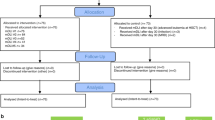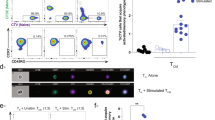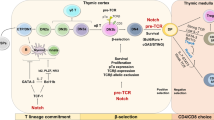Abstract
Because of their increased malignancies, autoimmune diseases, and infections, patients with Down syndrome (DS) show features of immunodeficiency. The DS thymus and T lymphocyte subsets have indeed proven to be different, and this has been interpreted as precocious aging. Our study on T lymphocyte subpopulations in DS shows that the normal expansion of naive helper (CD4+CD45RA+) and cytotoxic (CD8+CD45RA+CD27+) T lymphocytes is lacking in the first years of life; this is more logically explainable with an intrinsic T lymphocyte defect. Furthermore, memory cell numbers are not different from age-matched controls (AMC), which does not support the hypothesis of precocious aging. Although the absolute numbers of T lymphocyte subpopulations approach AMC levels toward adulthood, the persistent clinical problems suggest that these cells may not function optimally. However, the clinical picture does not fit severe T lymphocyte deficiency. The latter concept is also supported by our finding that cytomegalovirus (CMV)-seropositive DS children show similar numbers of terminally differentiated cytotoxic T lymphocytes when compared with healthy children, not increased numbers as are seen in immunocompromised hosts.
Similar content being viewed by others
Log in or create a free account to read this content
Gain free access to this article, as well as selected content from this journal and more on nature.com
or
Abbreviations
- AMC:
-
Age-matched control
- BD:
-
Becton Dickinson
- CMV:
-
Cytomegalovirus
- DS:
-
Down syndrome
- NK:
-
Natural killer
- PE:
-
Phycoerythrin
- PE-Cy5:
-
PE-cyanin 5
- Tc:
-
Cytotoxic T
- Th:
-
Helper T
References
Fabia J, Droletter M 1970 Malformations and leukemia in children with Down syndrome. Pediatrics 45: 60–70
Goldacre MJ, Wotton CJ, Seagroatt V, Yeates D 2004 Cancers and immune related diseases associated with Down syndrome: a record linkage study. Arch Dis Child 89: 1014–1017
Fraumeni JF, Manning MD, Mitus WJ 1971 Acute childhood leukemia: epidemiological study by cell type in 1263 cases at the Children's Cancer Research Foundation in Boston. J Natl Cancer Inst 46: 461–470
Miller RW 1970 Neoplasia and Down's syndrome. Ann NY Acad Sci 171: 637–644
Storm W 1990 Prevalence and diagnostic significance of gliadin antibodies in children with Down syndrome. Eur J Pediatr 149: 833–834
Karlsson B, Gustafsson J, Hedov G, Ivarsson SA, Anneren G 1998 Thyroid dysfunction in Down's syndrome: relation to age and thyroid autoimmunity. Arch Dis Child 79: 242–245
Sanchez-Albisua I, Storm W, Wascher I, Stern M 2002 How frequent is coeliac disease in Down syndrome?. Eur J Pediatr 161: 683–684
Garrison MM, Jeffries H, Christakis DA 2005 Risk of death for children with Down syndrome and sepsis. J Pediatr 147: 748–752
Levin S, Schlesinger M, Handzel ZT 1979 Thymic deficiency in Down's syndrome. Pediatrics 63: 80–83
Murphy M, Lempert MJ, Epstein LB 1990 Decreased level of T cell receptor expression by Down syndrome (trisomy 21) thymocytes. Am J Med Genet Suppl 7: 234–237
Murphy M, Epstein LB 1990 Down syndrome (trisomy 21) thymuses have a decreased proportion of cells expressing high levels of TCR alpha, beta and CD3. Clin Immunol Immunopathol 55: 453–467
Larocca LM, Lauriola L, Ranelletti FO, Piantelli M, Maggiano N, Ricci R, Capelli A 1990 Morphological and immunohistochemical study of Down syndrome thymus. Am J Med Genet Suppl 7: 225–230
Musiani P, Valitutti S, Castellino F, Larocca LM, Maggiano N, Piantelli M 1990 Intrathymic deficient expansion of T cell precursors in Down syndrome. Am J Med Genet Suppl 7: 219–224
Kusters MA, Verstegen RH, Gemen EF, de Vries E 2009 Intrinsic defect of the immune system in children with Down syndrome: a review. Clin Exp Immunol 156: 189–193
Burgio GR, Lanzavecchia A, Maccario R, Vitiello A, Plebani A, Ugazio AG 1978 Immunodeficiency in Down's syndrome: T-lymphocyte subset imbalance in trisomic children. Clin Exp Immunol 33: 298–301
Cossarizza A, Monti D, Montagnani G, Ortolani C, Masi M, Zannotti M, Franceschi C 1990 Precocious aging of the immune system in Down syndrome: alteration of B lymphocytes, T lymphocyte subsets, and cells with natural killer markers. Am J Med Genet Suppl 7: 213–218
Cossarizza A, Ortolaini C, Paganelli R, Barbieri D, Monti D, Sansoni P, Fagiolo U, Castellani G, Bersani F, Londei M, Franceschi C 1996 CD45 isoform expression on CD4+ and CD8+ T cells throughout life, from newborns to centenarians: implications for T cell memory. Mech Ageing Dev 86: 173–195
Murphy M, Epstein LB 1992 Down syndrome peripheral blood contains phenotypically mature CD3+TCR alpha, beta+ cells but abnormal proportions of TCR alpha, beta+, TCR gamma, delta+ and CD4+CD45RA+ cells: evidence for an inefficient release of mature T cells by DS thymus. Clin Immunol Immunopathol 62: 245–251
Prada N, Nasi M, Troiano L, Roat E, Pinti M, Nemes E, Lugli E, Ferraresi R, Ciacci L, Bertoni D, Biagioni O, Gibertoni M, Cornia C, Meschiari L, Gramazio E, Mariotti M, Consolo U, Balli F, Cossarizza A 2005 Direct analysis of thymic function in children with Down's syndrome. Immun Ageing 2: 4
Roat E, Prada N, Lugli E, Nasi M, Ferraresi R, Troiano L, Giovenzana C, Pinti M, Biagioni O, Mariotti M, Di Lorio A, Consolo U, Balli F, Cossarizza A 2008 Homeostatic cytokines and expansion of regulatory T cells accompany thymic impairment in children with Down syndrome. Rejuvenation Res 11: 573–583
De Hingh YC, van der Vossen PW, Gemen EF, Mulder AB, Hop WC, Brus F, de Vries E 2005 Intrinsic abnormalities of lymphocyte counts in children with Down syndrome. J Pediatr 147: 744–747
Kuijpers TW, Vossen MT, Gent M, Davin JC, Roos MT, Wertheim-van Dillen PM, Weel JF, Baars PA, van Lier RA 2003 Frequencies of circulating cytolytic, CD45RA+CD27−, CD8+ T lymphocytes depend on infection with CMV. J Immunol 170: 4342–4348
Bekker V, Bronke C, Scherpbier HJ, Weel JF, Jurriaans S, Wertheim-van Dillen PM, van Leth F, Lange JM, Tesselaar K, van Baarle D, Kuijpers TW 2005 Cytomegalovirus rather than HIV triggers the outgrowth of effector CD8+CD45RA+CD27− T cells in HIV+-infected children. AIDS 19: 1025–1034
Comans-Bitter WM, de Groot R, van den Beemd R, Neijens HJ, Hop WC, Groeneveld K, Hooijkaas H, van Dongen JJ 1997 Immunophenotyping of blood lymphocytes in childhood. J Pediatr 130: 388–393
Kraan J, Gratama JW, Keeney M, D'Hautcourt JL 2003 Setting up and calibration of a flow cytometer for multicolor immunophenotyping. J Biol Regul Homeost Agents 17: 223–233
Elsayed SM, Elsayed GM 2009 Phenotype of apoptotic lymphocytes in children with Down syndrome. Immun Ageing 6: 2
Sustrova M, Sarikova V 1997 Down's syndrome—effect of increased gene expression in chromosome 21 on the function of the immune and nervous system [in Slovak]. Bratisl Lek Listy 98: 221–228
Chinen J, Rosenblatt HM, O'Brian Smith E, Shearer WT, Noroski LM 2003 Long-term assessment of T-cell populations in DiGeorge syndrome. J Allergy Clin Immunol 111: 573–579
Jawad AF, McDonald-McGinn DM, Zackai E, Sullivan KE 2001 Immunologic features of chromosome 22q11.2 deletion syndrome (DiGeorge syndrome/velocardiofacial syndrome). J Pediatr 139: 715–723
Burgio GR, Ugazio AG, Nespoli L, Maccario AF, Botelli AM, Pasquali F 1975 Derangements of immunoglobulin levels, phytohemagglutinin responsiveness and T and B cell markers in Down's syndrome at different ages. Eur J Immunol 5: 600–603
Acknowledgements
We thank patients and parents for their cooperation with the study and Mr. Jeroen Ooms for preparing the figures.
Author information
Authors and Affiliations
Corresponding author
Additional information
Supported by the JBZ Research Fund and the Irene Foundation.
Rights and permissions
About this article
Cite this article
Kusters, M., Gemen, E., Verstegen, R. et al. Both Normal Memory Counts and Decreased Naive Cells Favor Intrinsic Defect Over Early Senescence of Down Syndrome T Lymphocytes. Pediatr Res 67, 557–562 (2010). https://doi.org/10.1203/PDR.0b013e3181d4eca3
Received:
Accepted:
Issue date:
DOI: https://doi.org/10.1203/PDR.0b013e3181d4eca3
This article is cited by
-
Importance of TREC and KREC as molecular markers for immunological evaluation of down syndrome children
Scientific Reports (2023)
-
Increased rate of respiratory symptoms in children with Down syndrome: a 2-year web-based parent-reported prospective study
European Journal of Pediatrics (2022)
-
Toxoplasma gondii Infection Among Institutionalized Children with Down syndrome in Sana’a city, Yemen: Implications of Low IgG Seroprevalence
Acta Parasitologica (2022)
-
A Prevalent CXCR3+ Phenotype of Circulating Follicular Helper T Cells Indicates Humoral Dysregulation in Children with Down Syndrome
Journal of Clinical Immunology (2020)
-
Down syndrome, accelerated aging and immunosenescence
Seminars in Immunopathology (2020)



